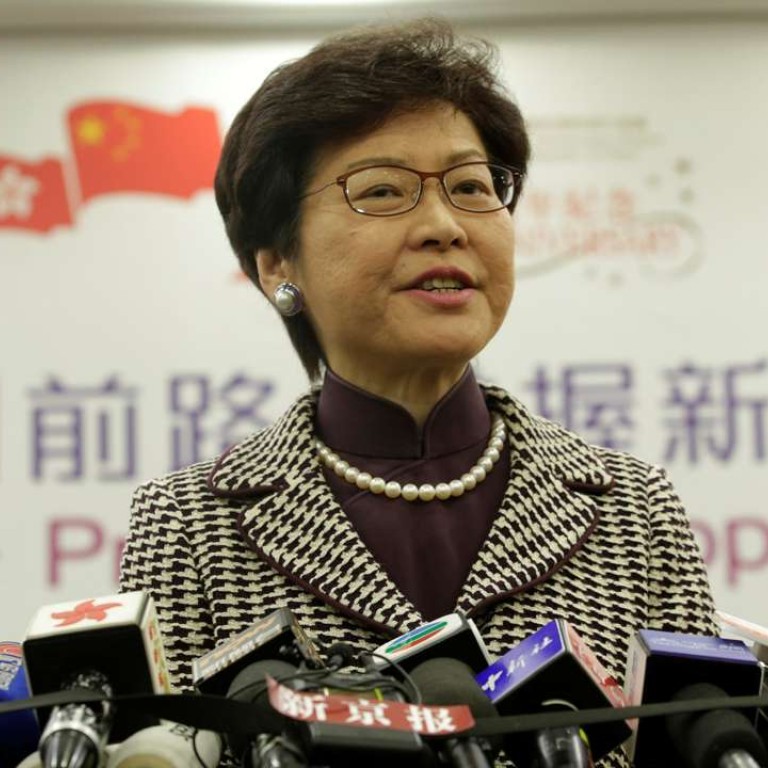
Can we expect companies to embrace gender diversity as Carrie Lam becomes CE? Not so fast
With Carrie Lam Cheng Yuet-ngor poised to become the first female leader of Hong Kong from July 1, many are hoping that her pioneering role will encourage more females to take up directorship positions among Hong Kong companies.
But those expectations could end in disappointment, as overseas experience shows that women occupying the highest echelons of political power does not necessarily translate into change in the corporate sphere.
Park Geun-hye took office as South Korea’s first female head of state in February 2013. In spite of the breakthrough, the country ranks bottom of the list in Asia in terms of female representation on company boards, with only 2.6 per cent of board positions held by women in 2014, according to global executive search firm Korn Ferry. Park was removed from office in March after being impeached in a wide-ranging corruption scandal.
South Korea lags well behind its regional neighbours on this measure, according to the report. In China 12.9 per cent of board positions are held by women, in Malaysia 12.5 per cent, while Hong Kong has 10.7 per cent and Singapore 7.7 per cent.

Angela Merkel assumed office as chancellor of Germany in November 2005, becoming the first woman to hold the post. However only 19 per cent of board positions at German companies were held by female directors in 2014, below 28 per cent in France, which has never had a female president.
Some European countries such as France and Germany are considering quotas that would set gender targets in an effort to promote greater representation by women on corporate boards.
A quota system introduced in Norway in 2004, which requires 40 per cent of board positions be set aside for women, has yielded a major change in corporate culture. Norway ranks No 1 in gender equality at the board level, with 36 per cent of positions held by women, higher than the US at 19 per cent, the European Unon at 20.8 per cent and Britain at 26 per cent.
Andrew Tsui, chairman of Korn Ferry International (HK), said the study has shown political female leaders may not always lead to big improvements for women in the boardroom.
And because Hong Kong companies are slightly outpacing their regional peers in terms of gender diversity on boards, the impact of Lam’s role as Chief Executive might not be all that substantial.
“As evidenced by the latest regional survey, despite having had women political leaders in the region for years in various countries, diversity in the private sector board room still has not improved much. It may be more deep seated than what it would seem,” Tsui said.
Brenda Trenowden, the global chair of 30% Club, however believes Lam’s rise to the top of Hong Kong political sector will make a difference.
“The 30% Club continually reinforces the importance of female role models in senior positions, not only as an encouragement to women but also as an important factor in helping both women and men to overcome their biases against women as leaders,” Trenowden said.
For example, she points to an 1993 initiative in India that required a third of seats on village councils be set aside for women as having a positive impact on parents’ career aspirations for their daughters.
“Former Icelandic President Vigdas Finnbogadottir got letters from young boys asking if she thought a boy would ever become president! That shows how much role models can impact gender norms,’” Trenowden said.
“In Britain, we now have many role models for women in the political arena including Prime Minister Theresa May, our Scottish First Minister Nicola Sturgeon, and Home Secretary Amber Rudd. Cressida Dick was recently appointed Met Police Commissioner. They will undoubtedly improve the balance in terms of gender norms and aspirations for women and girls,” she said.
John Yeap, a partner at lawyer firm Pinsent Masons, also believe Lam’s ascendence may help.
“Being the Chief Executive of Hong Kong is the most senior political role in Hong Kong, it is likely to encourage other women to climb to top levels of the corporate ladder,” he said.
Yeap added that his own firm strives to promote female lawyers by creating a supportive environment, such as offering flexible working hours that can make it easier to balance responsibilities at home.
In the local banking sector, HSBC’s Hong Kong office and subsidiary Hang Seng Bank are both helmed by female chief executives.
“HSBC has given me and many other women in senior management great opportunities and a truly meritocratic environment in which to develop our careers,” said HSBC’s Hong Kong chief executive Diana Cesar
“We continue to address gender representation to ensure that talented women have the opportunities and support they need to progress to senior management,” she said.
A Credit Suisse report last year showed that between the end of 2013 and mid-2016 companies with 25 per cent of management roles filled by women recorded 2.8 per cent growth in their share price, while those with 33 per cent female managers recorded 4.8 per cent growth and those with more than 50 per cent 10.3 per cent. This compares to an overall average share price fall of 1 per cent.
These companies also benefit shareholders, as dividend payouts are 9 per cent higher on average, according to the report.


